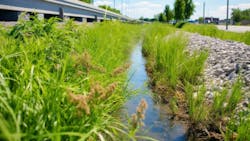It is always easier to discuss the negativity in the news, but there are also positive and constructive happenings occurring that are not discussed. Why? Because that does not generate clicks, views or likes. There are certainly things to be worried about in the stormwater sector as well. We consistently hear about the lack of funding, the growing size and number of coastal dead zones, and the challenge of addressing new and emerging contaminants. Added to this list is the overhanging concern of climate change. While it is good to be aware of these very real concerns, we cannot get mired in an ongoing downward spiral of negativity. This affects what I refer to as our “stormwater self-esteem," which is the term I use to describe the state of mind of many of us in the stormwater sector who often feel overwhelmed and underappreciated. For those suffering from a bruised stormwater self-esteem, it is good to take stock from time-to-time on the positives in our sector. Here are three reasons to be hopeful as we move ahead in our sector today.
1. There have been some “wins"
They say the hardest thing to do in sports is to hit a round ball with a round bat. A similar statement could be made that the hardest thing to do in water quality is to get clean water from polluted runoff. But there have been victories in this area by looking at the source of polluted runoff. In California, there was a bill signed into law in 2010 by then Gov. Schwarzenegger to prohibit the sale of brake pads containing copper and other toxins above trace amounts with amounts going down to almost zero by 2025. Leaders in California have moved on to zinc as the next targeted pollutant associated with automobiles, and researchers at the Washington Stormwater Center identified the acute toxicity of 6PPD from tires to salmonids which has garnered international attention. Identifying the source of toxins in the environment provides us with the opportunity to find non-toxic alternatives as the ultimate true source control. Ongoing research is finding more of these toxins and their sources, which provides a roadmap to address these pollutants at the root of the problem.
2. More Awareness & Credibility
I was helping my 13-year-old son with his schoolwork recently and found out he has been learning about watersheds, floodplains and coastal dead zones in his earth science curriculum. I do not know what you were studying in 7th grade, but I can assure you that we were taught NONE of these concepts when I was that age. This reflects the growing awareness of runoff-oriented topics today. Due to the efforts of organizations, there have been three statistically significant surveys of the needs and challenges in MS4 programs over the last six years, which have highlighted significant findings, such as the issues of aging infrastructure, workforce challenges in the MS4 sector and an estimated funding gap for the sector. The American Society of Civil Engineers included stormwater as a separate infrastructure category for the first time in its Infrastructure Report Card in 2021 (with a grade of D!) and are planning to continue this again in 2025. All these point toward a growing awareness in the public as well as within the broader infrastructure community that stormwater is, in fact, a legitimate infrastructure sector.
3. More support than ever before
The Infrastructure Investment and Jobs Act (IIJA) of 2021 was a game changer in the water sector overall and included more authorized funding for the stormwater sector than ever before. Translating authorized funding to appropriated funding has been a bigger challenge, but the appropriation of the proposed Centers of Excellence for Stormwater Infrastructure Technologies (CESITs) is an example of the increased support that is being provided to the stormwater sector. Up to five CESITs will be established by the end of 2024, representing a major step forward in research. Assuming the funding for the CESITs is increased and extended beyond the current twoyear funding window, these centers may prove to be the start of a new wave of advancements in the stormwater sector. So, as you take on your next project, I hope your stormwater self-esteem is bolstered by the knowledge that we are going in the right direction.






